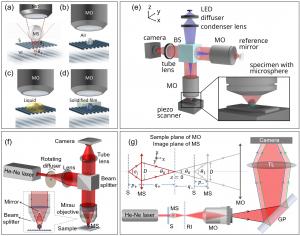Microsphere-assisted quantitative phase microscopy
USA, August 27, 2024 /EINPresswire.com/ -- An international teams of authors provide a comprehensive review on microsphere-assisted quantitative phase microscopy, a technique in which transparent microspheres are integrated with coherence scanning interference and digital holographic microscopies to enhance imaging resolution. The authors discuss the associated open questions, technical challenges, and research and development opportunities as well.
Light microscopes, undoubtedly, are one of the most widely used devices for sample inspection in life and material sciences. Conventional microscopes translate the difference in intensity in an object to a brightness difference in the image. A phase microscope, on the other hand, converts the spatial differences in phase in the object to a difference in pixel brightness in the image. Interference microscopy, a phase-based approach, has found application in various disciplines. The spatial resolution in light microscopy is limited due to the wave nature of light. Enhancing the resolution in microscopy has been subject to intense investigation since the invention of the microscope. In the past decade, microsphere-assisted microscopy, the use of transparent microspheres to enhance the resolution, has emerged as a simple yet efficient approach to enhance microscopy resolution. Microsphere-assisted microscopy has been used in combination with several microscopic imaging techniques such as confocal, fluorescent, second harmonic generation, two-photon, dark-field, and interferometric and digital holographic microscopies to either improve their performance or provide new functionalities.
In a new paper (doi: https://www.light-am.com/en/article/doi/10.37188/lam.2024.006 ) published in Light: Advanced Manufacturing, international teams of authors, invited by Arash Darafsheh from Washington University School of Medicine in St. Louis, joined together to provide a comprehensive review on microsphere-assisted quantitative phase microscopy, the integration of microspheres with coherence scanning interference and digital holographic microscopies, while discussing the associated open questions, challenges, and opportunities.
Microsphere-assisted microscopy is a versatile technique that can be extended to coherence scanning interference and digital holographic microscopies to achieve 3D imaging with improved resolution. Microsphere-assisted interference microscopy offers a cost-effective and non-destructive high-speed single-shot imaging method for 3D surface metrology, and microsphere-assisted digital holographic microscopy provides a real-time method for high-contrast quantitative phase imaging in both transmission and reflection modes. Furthermore, quantitative phase microscopy arrangements improved by microspheres have the flexibility to be integrated with other methodologies, such as structured illumination and oblique illumination, to achieve further enhancements in resolution or other adjustments.
There is ample room for research in microsphere-assisted microscopy as discussed in this review. From the theoretical viewpoint, a comprehensive 3D model to describe the whole imaging system, including the illumination, microsphere, objective lens, 3D sample and its substrate, and imaging sensor would be of great interest to completely understand the resolution enhancement mechanism of microsphere-assisted microscopy. Besides a better understanding, full models help to further improve the resolution by optimizing system parameters. However, such models require an extremely large computational effort and hence cannot be implemented on current conventional computers. From the experimental point-of-view, implementation of microsphere-assisted microscopy in some scenarios may not be very straightforward; for example, the field-of-view is small and the speed for investigating larger areas may not be high. Overcoming these issues would bring new possibilities for the future of microsphere-assisted microscopy.
DOI
10.37188/lam.2024.006
Original Source URL
https://www.light-am.com/en/article/doi/10.37188/lam.2024.006
Lucy Wang
BioDesign Research
email us here
Legal Disclaimer:
EIN Presswire provides this news content "as is" without warranty of any kind. We do not accept any responsibility or liability for the accuracy, content, images, videos, licenses, completeness, legality, or reliability of the information contained in this article. If you have any complaints or copyright issues related to this article, kindly contact the author above.

